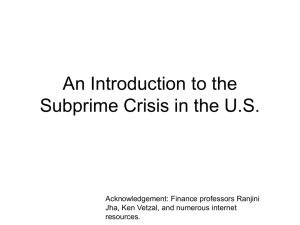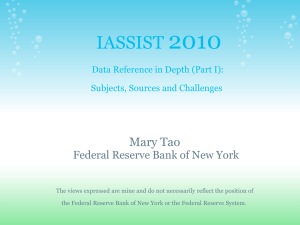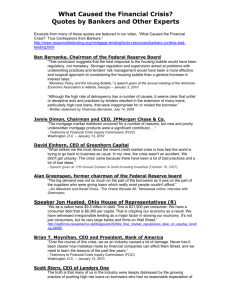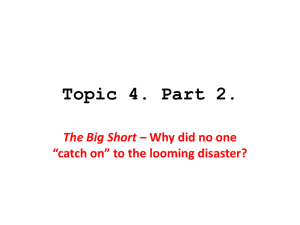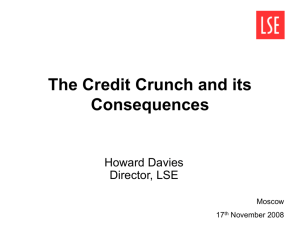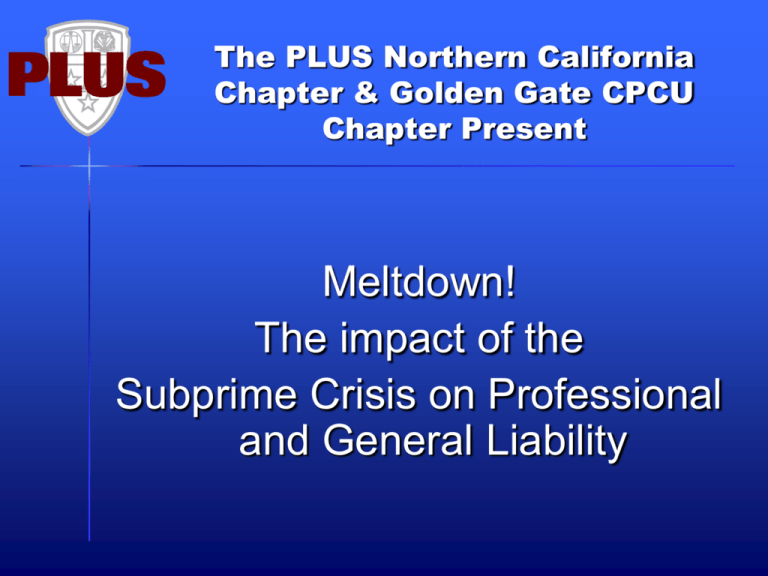
The PLUS Northern California
Chapter & Golden Gate CPCU
Chapter Present
Meltdown!
The impact of the
Subprime Crisis on Professional
and General Liability
Speakers
• Hal Weston, JD, CPCU, ARM, Weston
Consultancy
• Bill Dougherty, CIC, RPLU
• Sean Simpson, Sedgwick Detert Moran &
Arnold
• Scott Meyer, President, Financial Institutions
Group - AIG Executive Liability
• Karen Clopton, General Counsel, CA
Department of Corporations
Past Bubbles
1970s - Gold & Silver
1980s - S&L & Commercial Real Estate;
Japanese stocks
1990s - Tech/Dot.com; Emerging Markets
2000s - Real Estate
Some History
• 1983: Collateralized Mortgage Invented
• 1986: Tax Reform Act - home equity loans
gain preference
• 1994: Sub prime & Alt A Mortgages arise
• 2000: HUD / Treasury Predatory lending
report
• 2002: HUD report re Sub Prime Market and
role of GSE
• 2002: Increased demand for private label
MBS
History - continued
• 2003: Home Ownership Dream Down
Payment Act
• 2004: Greenspan addresses issue of Real
Estate/housing bubble
• 2005: 40% of all home purchases are for
investment; $625B in sub prime originated.
33% at 100% LTV
Key statistics
TOP ISSUERS OF CDOS - 2007
Merrill Lynch
Citigroup
Barclays Capital
ABN Amro
Deutsche Bank
Goldman Sachs
Wachovia
UBS
JPMorgan Chase
Bank of America
TOTAL
ISSUANCE JAN- GROWTH SINCE
JUNE 2007
JAN-JUNE 2006
$
33.4
46%
$
28.0
45%
$
24.7
187%
$
18.0
1130%
$
17.0
30%
$
16.9
6%
$
15.8
66%
$
15.0
75%
$
13.5
93%
$
12.8
20%
$
286.0
source, New York Times, Nov. 5, 2007
44%
Key statistics
BINGE & PURGE
Bank of America
Citicorp
Countrywide
Credit Suisse
Deutsche Bank
Fannie Mae
Freddie Mac
HSBC
Lehman Brothers
Merrill Lynch
UBS
Wachovia
Washington Mutual
•*Economist, New York Times
WRITEDOWNS ON
CDOs &
CREDIT
$21.20
$54.60
$
NEW CAPITAL
RAISED
$
20.70
44.1b
$38b
$11b
$28b
$0
$27.40
$0.830b
$46.b
38.20
$7.3b
$14.8b
3.5b
$4b
$30b
28.60
$7b
$7b
$
SHARE PRICE
DECLINE SINCE
PEAK
33%
59%
79%
24%
32%
79%
86%
10%
68%
36%
60%
62%
88%
Key statistics
• Outstanding Mortgage backed securities increased
from $2.8 trillion in 2000 to $6.6 trillion in 2007*
• By 2007 20.6% of all mortgages originated are sub
prime
• As interest rates rose in 2007 sub prime past due
loans increased from 11.5% to 18.8% in one year bank net income decreases from $35B to 5.8B 16yr low
• Anticipated losses to banks and
investors: $945 BILLION!!
•*Washington Post
What We Know:
Pre 2007
Bubble Conditions Pre 2007
•
During the period 2000 to 2007, the U.S. banking industry
posted record earnings.
- S&P Banking Index peaked at 406 points in December
of 2006, up from 279 as of January 2003.
[MSN]
•
Subprime mortgage loan originations surged by 25% per
year between 1994 and 2003.
- The result was a near ten fold increase in the volume of
these loans in the last nine years.
[FDIC]
•
Google Finance’s index of 2000 publicly traded finance
companies showed gains of 15% annually from 2005-2007
What We Know:
Pre 2007
• Since 2000, the volume of US mortgage lending financed by
securizations was seven times higher than the level funded by
traditional bank loans.
[Oppenheimer]
• Between 2000 and 2005, increases in home prices were six
times greater than increases in household incomes.
[JCHS of Harvard University-2006]
• In 2003, mortgages with a loan-to-value ratio exceeding 80%
accounted for 30% of all purchased mortgages underwritten.
In a few cities, this share exceeded 50%.
[FDIC]
What We Know
July 2008
• Over a 100 companies have announced writedowns or other
adverse financial impacts stemming from the purchase and
sale of subprime mortgage backed securities, CMOs and
CDOs.
[GDC, LLP]
As of July 2008, it has been estimated that the U.S.
subprime mortgage market has cost financial institutions
worldwide $410 billion in losses and writedowns.
[Bloomberg]
What We Know:
Litigation
Subprime Litigation in 2007
• 278 subprime related suits brought in 2007
- 65% (181) in the last six months of 2007
• Borrower class actions (43%)
• Securities cases (22%)
54% securities fraud class actions
D&O’s individually named as defendants in 97% of
these class actions
• Commercial contract disputes (22%)
• Other, employment class actions, bankruptcy related,
etc.
What We Know:
Litigation
Subprime Litigation in Q1 2008
•
170 subprime lawsuits filed in Q1 2008, approaching the 181 filings over the
final six months of 2007.
[Navigant Consulting]
Summary of Subprime Litigation to date
•
Brings total to 448 over the last 15 months, as of March 31, 2008.
Borrower class actions (46%), Securities cases (26%), Commercial
contract disputes (10%)
42% of the filed 448 cases, at least one Fortune Global 500 company
was named as a defendant
10% named at least one non-U.S. Global 500 company as a defendant
(50% in U.K.)
[Navigant Consulting]
What We Know:
Litigation
Current Credit Market Compared to the Savings & Loan Crisis
•
In 2007 alone, there were already half as many subprime related lawsuits as
the S&L crisis (559).
[Navigant Consulting]
S&L Crisis
4,000 savings and loan institutions became insolvent; eventually costing
taxpayers $124B ($400B in 2007 dollars).
Savings and Loans Crisis was largely an institutional and domestic
problem – today, it is also a consumer and global problem.
Subprime
Two major mortgage lenders filed for bankruptcy (New Century and
American Home Mortgage)
•
•
IndyMac and Countrywide
300 bank failures predicted by 2010
[MarketWatch]
What We Know:
Litigation
• Allegations:
False financial statements – challenge the integrity of the
issuer’s financial statement.
Misleading disclosure regarding loan practices –
underwriting practices were different than previously disclosed.
Undisclosed risk of subprime market collapse – issuers
failed to warn investors of potential market collapse, e.g.
Countrywide.
Undisclosed exposure to subprime – issuer failed to disclose
the nature and extent of its involvement in subprime-related
business activities, e.g. Citigroup.
Undisclosed sell-off of subprime securities – material
misrepresentations and omissions by failing to disclose the fact
that while they were securitizing these types of assets, they were
selling off their own subprime portfolio.
What We Know:
Litigation
Defendants and Jurisdictions (2007 suits)
•
Mortgage Bankers & Loan Correspondents (32%)
- Also, mortgage brokers, lenders, appraisers, title companies,
homebuilders, servicers, issuers, underwriting firms,
securitization trustees, bond insurers, rating agencies, money
managers, public accounting firms and company D&O’s, etc.
- Fortune 1000 companies were named in 56% of cases
- Each of the top ten subprime mortgage lenders for 2006 was
named in at least one borrower class action suit in 2007
•
California and New York account for approximately 50% of all
cases filed
- California is the largest U.S. market for high-risk home loans
as half of the 20 biggest U.S. subprime lenders are located in
California
[Inside Mortgage Finance]
What We Know: July
2008
Corrective Actions Taken
• The SEC has formed the “Subprime Task Force” that includes all
divisions of the SEC, to focus on investigations into possible
misconduct in the subprime industry. The Enforcement Division of
the SEC disclosed that it has three dozen active investigations.
• The DOJ has also become active in the investigation of potential
criminal aspects of the subprime meltdown. In late January 2008,
the FBI said that it has opened criminal inquiries on at least 14
companies.
• Attorneys general are actively pursuing investigations into possible
violations of state law issuing subpoenas to a wide variety of market
participants. In June 2008, California Attorney General Brown sued
Countrywide and in July 2008, New York Attorney General Cuomo
filed a civil suit against UBS.
[GDC, LLP]
What We Know: D&O
Impact on D&O Market
•
•
•
•
Insurance capacity is constrained
Retentions and deductibles are increasing
Premium rates are increasing
Other terms and conditions are affected
Subprime & Credit
Crisis Timeline
Feb ’07 - HSBC fires
head of its US
mortgage lending
business as losses
reach $10.5B.
June ’07 - $3.2B
move by Bear
Stearns to rescue
fund.
Nov. ’07 - Wachovia revealed
a $1.1B loss due to decline in
value of its mortgage debt plus
$600M to cover loan losses.
March ’08 - Bear Stearns is
acquired by JPMorgan Chase
for $240m, a fraction of its
share price, in deal backed by
$30bn in Fed loans.
Wachovia CEO Ken
Thompson resigns 7 months
later.
July ’08 - Indymac Bancorp is
seized by federal regulators.
Freddie Mac and Fannie Mae
experience heaviest trading day
on record.
?
?
Today
April ’07 - New Century
Files Chapter 11 and
Accredited Home and
American Home can’t fund
mortgages.
Oct. ’07 - Merrill Lynch
reveals $5.6B subprime
loss and $7.9B hit
following exposure to
bad debt.
Feb. ’08 - AIG estimates
writedowns for 2007 would
be $5.2B, more than triple
the $1.6bn disclosed in
Dec.
Merrill CEO E. Stanley
O’Neal resigns.
AIG CEO Martin Sullivan
resigns 4 months later.
Nov. ’07 - Citigroup
announces fresh losses of
between $8B and $11B
because of exposure to the
US subprime market.
?
?
?
YE 2008 and BeyondA recent study by
Bridgewater Associates
pegs the new estimate on
writedowns at $1.6T.
April ’08 - Citigroup reveals
another $12B in subprime
losses, bringing its total to
$40B.
Citi CEO & Chairman Charles
O. Prince resigns.
NOT TO SCALE
What We Know, We Don’t
Know
Unknown, Unknowns…
• In Nov. 2007, Citigroup announces losses of approximately $10B
because of exposure to the U.S subprime market.
- Did we know they would writedown an additional $12B in subprime losses,
bringing its total to $40B?
•
Of the $410 billion of current estimated losses and writedowns, a
significant portion of it is related to CMOs and CDOs.
- 24 months ago did the average investor know what these financial instruments
were?
•
Auction Rate Securities – investments at the center of the latest
probe in the credit markets.
- 6 months ago, did anyone really know what they were?
•
IndyMac, with $32B in assets, is the largest bank failure in 24
years.
- Could this be the beginning of a string of failures comparable to the 3,000 bank
closings in the 1980s?
Unknown, Unknowns
• Is the securitization market for residential mortgages closed
forever?
• Will Fannie Mae and Freddie Mac be nationalized?
• Is the FDIC in a financial position to bail out all failing banks?
• How many other banks will fail?
• With the U.S. sovereign credit rating be damaged?
• Will the housing rescue bill, recently passed by the Senate, be
effective?
The Problem With
Unknowns
The D&O Industry does not know the
systemic impact of the Credit Crisis.
•
Total Cost
•
Additional Losses
•
Average Settlement
•
The Industry Knows That It Does Not Know What Will Be Next…
Knowing What We
Know…
Conclusions & Assumptions Based
On Unknown Unknowns….
•
Is there any way to predict or prepare for the uncertain future?
•
What unforeseen outcomes lie ahead?
•
What will be the next “Crisis?”
•
Impact both for and because of the global marketplace?
Conclusion
• “All truth passes through three phases: First, it is ridiculed. Second,
it is violently opposed, and Third, it is accepted as self-evident.”
•
Arthur Schopenhauer, 19th Century German Philosopher
• “All truths are easy to understand once they are discovered; the
point is to discover them.”
•
Galileo
• “The great enemy of the truth is very often not the lie—deliberate,
contrived and dishonest—but the myth—persistent, persuasive and
unrealistic.”
•
JFK
• “As long as people believe in absurdities, they will continue to
commit atrocities.”
•
Voltaire
• “Hold on to your butts.”
•
Jurassic Park
Conclusion
Conclusion
© 2008 American International Group, Inc. All rights reserved.
Insurance Coverage Issues
Affecting Liability Claims
Sean Simpson
Sedgwick, Detert, Moran & Arnold LLP
3 Park Plaza, 17th Floor
Irvine, CA 92614-8540
August 13, 2008
Applicable Insurance
Coverages
•
•
•
•
•
Errors and Omissions Liability
Commercial General Liability
Directors and Officers Liability
Fiduciary Liability
Credit Risk Coverage
E&O Coverage – Insuring
Grant
Coverage generally afforded to
an Insured for Loss arising
from a Claim first made
against the Insured during the
Policy Period for a Wrongful
Act.
Wrongful Act /
Professional Services
• The term “Wrongful Act” in an E&O policy is generally defined
as a negligent act, error or omission committed by the Insured
in the performance of “professional services.”
• “Professional services” implicated in the subprime crisis
include:
Mortgage Lending
Mortgage Brokering
Real Estate Appraisal
Real Estate Brokering
Title Insuring
Escrow Services
Legal Services (in those states where lawyers are involved)
Alleged Wrongful Acts In
Subprime Context
• Misrepresentations to borrowers re terms of loan
and availability of other lending options
• Failure to make required disclosures
• Misrepresentations to lenders re borrower’s
finances
• Pressuring appraisers to inflate home values
• Racially discriminatory pricing
• Late posting of mortgage payments
• Improperly retained interest
• Improperly assessed foreclosure fees
• Failure to properly handle default during and after
borrower’s bankruptcy
Are The Requirements for
Wrongful Act Satisfied?
• Typical E&O issues:
Intentional?
“Professional services”
Investigative orders (e.g., "may have"
committed)
Who Is An Insured?
• Includes the named entity and its directors, officers,
partners or employees while acting within the scope of
their duties as such.
• Excludes other businesses that partner with the named
Insured.
• May exclude subsidiaries or other related companies.
• Contractors? Usually excluded. Add by endorsement.
Staff are usually independent contractors.
Is There A Claim?
• Claim -- written demand for money damages.
Investigations - are they claims? Some policies
expressly include investigations by a governmental
body or self-regulatory organization within the
definition of Claim
Complaint letters - are they claims?
• Inter-related acts: Wrongful Acts that have as a common
nexus any fact, circumstance, situation, event or
transaction or series of facts, circumstances, situations,
events or transactions.
First act, which policy period.
• Retentions for multiple claims
Impact of Insured’s
Dissolution
• Who pays retention if insured out of business?
• Policy provision: “[t]he Retention shall be borne
by the INSURED as its own uninsured risk and
shall be fully paid by the INSURED before
Underwriters shall incur any liability to pay any
LOSS”
• Under California law, an insurer generally has
no obligation to “drop down” and pay any Loss
until the retention has been exhausted. Vons
Cos., Inc. v. United States Fire Ins. Co. (2000)
78 Cal.App.4th 52, 63.
Dangers of Insured’s
Dissolution
• Defense attorney may withdraw for lack of payment.
• The claimant may pursue a third party claim against the
insurer.
Some court hold that the insurer may be liable for the
excess portion of the judgment. See Rummel v.
Lexington Ins. Co. (N.M. 1997) 945 P.2d 970;
UMC/Stamford, Inc. v. Allianz Underwriters Ins. Co.
(N.J. Super. Ct. Law Div. 1994) 647 A.2d 182.
Limitations on Loss
•“Loss” includes money damages, settlements and
defense costs.
•Exclude
Punitive damages usually excluded by definition of
loss, and uninsurable by law.
Criminal and civil fines.
Disgorgement. Pan Pacific Retail Properties v. Gulf
Insurance Company (9th Cir. 2006) 466 F.3d 867.
Limitations on Loss
Mortgage Fee Claims
• Exclude “Mortgage Fee Claim” - Claim arising
out of fees paid to or by the Insured in
connection with the loan process.
The exclusion may include a yield spread premium,
overage, premium pricing, yield spread differential,
par plus pricing, discharge fee, loan payoff charge
and late payment fee
Some policies include coverage for a Mortgage Fee
Claim, but limit coverage only to defense costs.
The Fraud and
Dishonesty Exclusion
• Exclude criminal, dishonest,
intentionally malicious, or fraudulent
acts.
Most fraud exclusions, however,
require either an “in-fact” determination
or a “final adjudication” that the actions
at issue were indeed fraudulent.
Known Claims or
Circumstances
Exclusion
•
Known loss or claim or circumstances.
•
actual or constructive knowledge prior to the
beginning of the Policy Period.
Given the breadth of the subprime crisis, was
insured aware of circumstances that could give
rise to a Claim
Other Potentially
Applicable Exclusions
•
Other potential exclusions that may be implicated
include exclusions for claims relating to:
• Yield spread premiums
• Loan servicing
• ERISA violations
• Defamation
• Wrongful eviction
• Invasion of privacy
• Non-monetary relief
• Loan repurchase
• Breach of warranty/guarantee
• Unfair competition
• Discrimination
• Assumption of liability under contract
• Advertising
• Governmental actions
• Corporate policies
CGL Coverage
• An insured is likely to pursue CGL
coverage where a claim can reasonably
be made
Defense Costs typically do not decrease limits
An award of plaintiffs’ attorneys fees may
constitute costs under the supplementary
payments provision, and thus, may not
decrease limits
Advertising Injury Cover
• Personal and advertising injury is generally defined to mean
injury arising out of certain specific offenses, including:
False arrest, detention, or imprisonment
Malicious prosecution
An owner, landlord or lessor’s wrongful eviction/entry
Oral or written publication that slanders or libels a person or
organization or disparages a person’s or organization’s products or
services
Oral or written publication that violates a person’s right to privacy
The use of another’s advertising idea in the insured’s advertisement
Infringing on another’s intellectual property in the insured’s
advertisement
Zurich American Insurance
Co. v.
Fieldstone Mortgage Co.
•
In Zurich Am. Ins. Co. v. Fieldstone Mortg. Co., 2007 U.S. Dist.
LEXIS 81570 (D. Md. Oct. 26, 2007), plaintiff alleged that he received
"prescreened" offers from Fieldstone Mortgage to refinance his
mortgage. The "prescreening" was allegedly based on information
contained in his consumer credit report, which was accessed without
his consent and without a permissible purpose under FCRA.
•
The court held that the alleged FCRA violations at issue fell within
the scope of the “personal and advertising injury coverage,” which
was defined to include injury arising out of certain distinct offenses,
including "[o]ral or written publication, in any manner, of material that
violates a person's right of privacy."
Advertising Injury
Exclusions
• Potentially applicable exclusions under the “advertising
injury” cover include:
Knowing violation of rights of another
• Advertising injury caused with knowledge that the act would violate the
rights of another and inflict advertising injury
Material published with knowledge of falsity
Material published prior to policy period
Criminal acts
Breach of contract
Qualify or performance of goods – Failure to conform to statements
• Advertising injury arising from the failure of products or services with any
statement of quality or performance made in the advertisement.
Wrong description of prices
Regulatory Impact
Federal Regulators Include:
OCC (Office of the Comptroller of the Currency) Federal
Reserve System (Board), FDIC, OTS and National Credit Union
Administration (NCUA) oversee the mortgage industry on a
national level.
Regulatory Impact
State Regulators:
Department of Corporations (DOC), Department of Real
Estate (DRE) and the Department of Financial Institutions
(DFI).
DOC Regulatory authority: Corporate Securities Law of 1968,
Franchise Investment Law, California Commodity Law of
1990, California Deferred Deposit Transactions Law, Finance
Lenders Law, Residential Mortgage Lending Act, Check
Sellers, Bill Payers and Proraters Law, and Escrow Law.
-- qualification of the offer and sale of securities and the
licensing and regulation of broker-dealers, broker-dealer
agents, investment advisers, and investment adviser
representatives pursuant to the Corporate Securities Law of
1968.
Regulatory Impact
Changes initiated to deal with the crisis:
State of California Initiatives
New regs to protect borrowers -requires lenders to consider a
borrower’s ability to repay at the higher reset interest rate.
Established Interdepartmental Task Force on Non-traditional
Mortgages to ensure a comprehensive and coordinated
approach to the issues raised by subprime loans.
Regulatory Impact
Regulation Z (Truth in Lending Act) , final rule, adopted under
the Home Ownership and Equity Protection Act (HOEPA).
Key protections:
• Prohibit a lender from making a loan without regard to
borrowers' ability to repay the loan from income and
assets other than the home's value.
• Require creditors to verify the income and assets they
rely upon to determine repayment ability.
• Ban any prepayment penalty if the payment can
change in the initial four years.
• Require creditors to establish escrow accounts for
property taxes and homeowner's insurance for all firstlien mortgage loans.
Regulatory Impact
• Additional new rules for loans secured by a consumer's
principal dwelling:
• Creditors and mortgage brokers are prohibited from coercing
a real estate appraiser to misstate a home's value.
Companies that service mortgage loans prohibited from
engaging in certain practices, such as pyramiding late fees.
Creditors must provide a good faith estimate of the loan
costs, including a schedule of payments, within three days
after a consumer applies for any mortgage loan secured by a
consumer's principal dwelling
For all mortgages, the rule also sets additional advertising
standards. Advertising rules now require additional
information about rates, monthly payments, and other loan
features. The final rule bans seven deceptive or misleading
advertising practices, including representing that a rate or
payment is "fixed" when it can change.
Impact and Changes in
the Insurance Market
What’s Next?
Long term impact on:
Regulations
Litigation - key lawsuits pending
Insurance - underwriting/ capacity
Questions?
PLUS and CPCU
THANK YOU!



